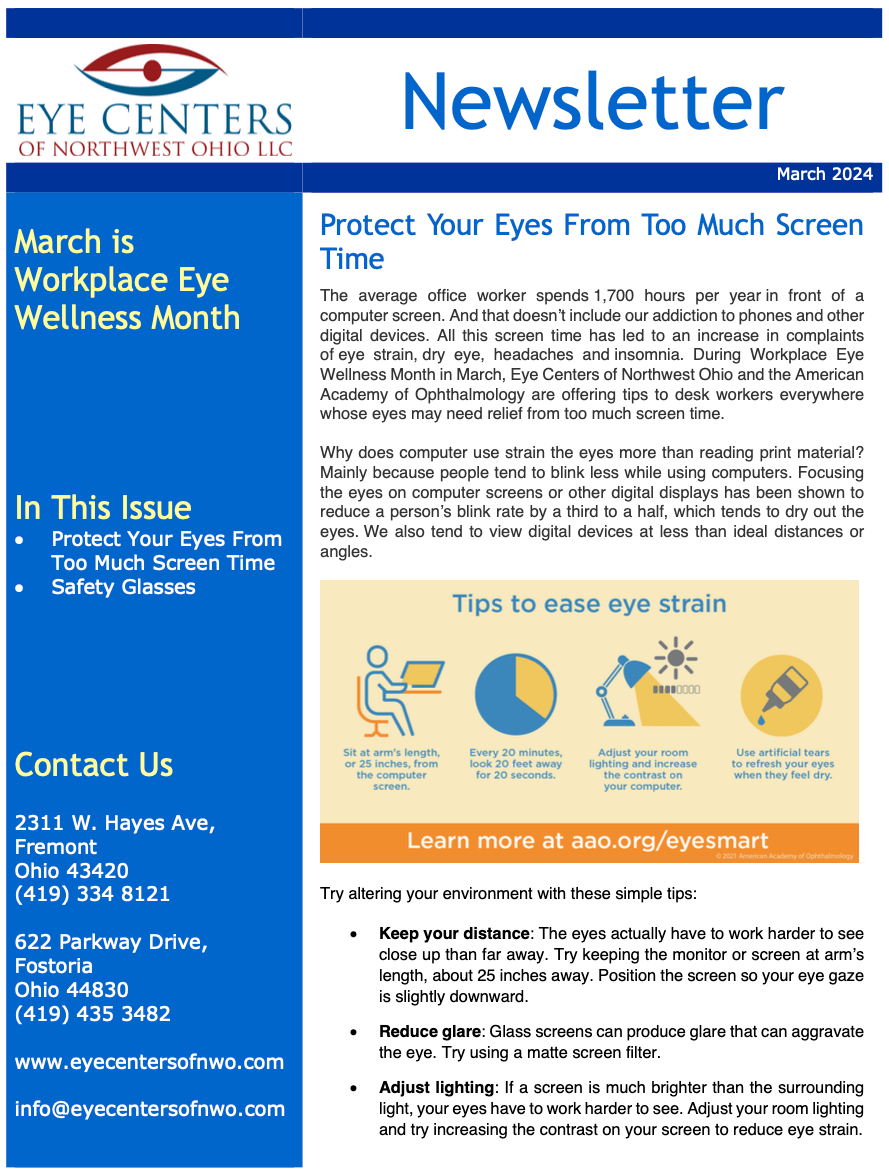March 2024 Newsletter
Protect Your Eyes From Too Much Screen Time
The average office worker spends 1,700 hours per year in front of a computer screen. And that doesn’t include our addiction to phones and other digital devices. All this screen time has led to an increase in complaints of eye strain, dry eye, headaches and insomnia. During Workplace Eye Wellness Month in March, Eye Centers of Northwest Ohio and the American Academy of Ophthalmology are offering tips to desk workers everywhere whose eyes may need relief from too much screen time.
Why does computer use strain the eyes more than reading print material? Mainly because people tend to blink less while using computers. Focusing the eyes on computer screens or other digital displays has been shown to reduce a person’s blink rate by a third to a half, which tends to dry out the eyes. We also tend to view digital devices at less than ideal distances or angles.
Try altering your environment with these simple tips:
Keep your distance: The eyes actually have to work harder to see close up than far away. Try keeping the monitor or screen at arm’s length, about 25 inches away. Position the screen so your eye gaze is slightly downward.
Reduce glare: Glass screens can produce glare that can aggravate the eye. Try using a matte screen filter.
Adjust lighting: If a screen is much brighter than the surrounding light, your eyes have to work harder to see. Adjust your room lighting and try increasing the contrast on your screen to reduce eye strain.
Give your eyes a break: Remember to blink and follow the 20-20-20 rule. Take a break every 20 minutes by looking at an object 20 feet away for 20 seconds. Looking into the distance allows your eyes to relax.
Keep eyes moist: Keep artificial tears at hand to help lubricate your eyes when they feel dry. Consider using a desktop humidifier. Office buildings have humidity-controlled environments that suck moisture out of the air. In winter, heaters on high can further dry your eyes.
Stop using devices before bed: There is evidence that blue light may affect the body’s circadian rhythm, our natural wake and sleep cycle. During the day, blue light wakes us up and stimulates us. So, too much blue light exposure late at night from your phone or other devices may make it harder to get to sleep. Limit screen time one to two hours before bedtime. Use nighttime settings on devices and computers that minimize blue light exposure.
If symptoms continue after trying these tips, make an appointment to see us.
Safety Glasses
Personal protective eyewear such as safety glasses with side shields, goggles, face shields, and/or welding helmets can protect you from common hazards, including flying fragments, large chips, hot sparks, optical radiation, and splashes from molten metals, objects, particles, and glare. The risk of eye injury and the need for preventive measures depend on your job and the conditions in your workplace.
At the Eye Centers of Northwest Ohio, we offer a comprehensive list of Safety Frames. You can view our Corporate Brochure and Safety Frame Catalogue by clicking the button below to learn more.
For previous newsletters:
www.eyecentersofnwo.com/newsletters
March is Workplace Eye Wellness Month
In This Issue
Protect Your Eyes From Too Much Screen Time
Safety Glasses
Contact Us
2311 W. Hayes Ave
Fremont
Ohio 43420
(419) 334 8121
622 Parkway Drive
Fostoria
Ohio 44830
(419) 435 3482
Courtesy: Prevent Blindness
Courtesy: National Eye Institute, National Institutes of Health (NEI/NIH)
No Vision Insurance, No Problem. Join our Membership Program today!
Courtesy: The American Academy of Ophthalmology
For previous newsletters:
We Now Have Paperless Check-In Available
Follow the link that we text to you the day before your appointment







